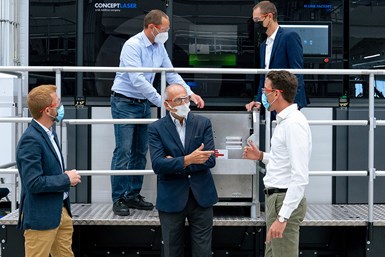Group Demonstrates Secured Cross-Continent Distributed Additive Manufacturing
The company says its digital platform virtualizes industrial 3D printing, enabling a simpler, secured and more efficient production process.
The company says its digital platform oversees the entire additive manufacturing thread from the initial part model to the verified physical part and beyond.
Assembrix partnered with Boeing, EOS, 3T Additive Manufacturing and BeamIt to successfully demonstrate secured cross-continent, distributed additive manufacturing (AM) — a fully controlled, 3D printing solution remotely connected directly to EOS 3D printers.
The company says its digital platform virtualizes industrial 3D printing, enabling a simpler, secured and more efficient production process. It oversees the entire AM thread, from the initial part model to the verified physical part and beyond.
The demonstration by the partnership companies is a major step toward enabling a secure and transparent 21st-century distributed AM supply chain model that could be used by companies across the world, the group says. The solution incorporates technology from Boeing, Assembrix’s Virtual Manufacturing System (VMS) platform and a blockchain, which is designed to be seamlessly integrated with EOS industrial 3D printing technologies.
The group says the demonstration proves the viability of a fully digitalized, globally distributed AM model with several features, including secured production in which jobs can be securely assigned to individual machines within a manufacturer, with the IP fully protected and an auditable transaction trail. This enables customers to ensure excess parts are not produced and protect their design instructions.
It also features real-time monitoring, so customers can monitor job progress in real-time. And it enables data collection and monitoring in which data from the machine can be monitored to ensure it is within the parameters defined by the customer for the job. This data may include machine bay humidity, temperature, print speed or cooling and more — all factors that can impact the performance and final quality of a part.
“We are providing our clients with a virtual additive manufacturing factory, where 3D printers using a variety of technologies and in different geographic locations are remotely and securely controlled,” says Lior Polak, Assembrix CEO. “This concept is breaking the boundaries of traditional manufacturing and makes distributed additive manufacturing a reality.”
Related Content
-
This Drone Bird with 3D Printed Parts Mimics a Peregrine Falcon: The Cool Parts Show #66
The Drone Bird Company has developed aircraft that mimic birds of prey to scare off problem birds. The drones feature 3D printed fuselages made by Parts on Demand from ALM materials.
-
At General Atomics, Do Unmanned Aerial Systems Reveal the Future of Aircraft Manufacturing?
The maker of the Predator and SkyGuardian remote aircraft can implement additive manufacturing more rapidly and widely than the makers of other types of planes. The role of 3D printing in current and future UAS components hints at how far AM can go to save cost and time in aircraft production and design.
-
Additive Manufacturing Is Subtractive, Too: How CNC Machining Integrates With AM (Includes Video)
For Keselowski Advanced Manufacturing, succeeding with laser powder bed fusion as a production process means developing a machine shop that is responsive to, and moves at the pacing of, metal 3D printing.















